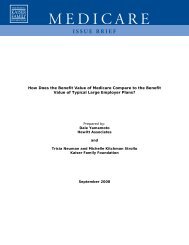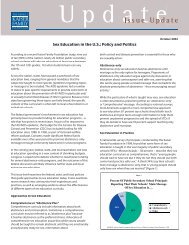HEALTH CARE COSTS: A PRimER - The Henry J. Kaiser Family ...
HEALTH CARE COSTS: A PRimER - The Henry J. Kaiser Family ...
HEALTH CARE COSTS: A PRimER - The Henry J. Kaiser Family ...
You also want an ePaper? Increase the reach of your titles
YUMPU automatically turns print PDFs into web optimized ePapers that Google loves.
What Can Be Done To Address Rising Costs?<br />
Finding a way to address high costs and cost growth without unreasonably reducing<br />
access to new and needed services is a significant challenge. 36 <strong>The</strong> information<br />
presented above shows that the United States faces two issues with health care costs:<br />
(1) the amount that is spent in the U.S. per person for health care is high, particularly<br />
when compared with the amounts peer nations pay for care (with almost half of U.S.<br />
health care spending used to treat just 5% of the population in 2009); and (2) health<br />
care expenditures grow rapidly relative to the economy overall, and have consistently<br />
done so for decades. Policymakers considering policy interventions related to costs<br />
need to distinguish between factors that affect how much health care costs at a point in<br />
time and factors that affect long-term cost growth.<br />
Some approaches for dealing with health care costs can make spending more<br />
effficient, but will not address some of the key underlying pressures fueling<br />
long-term cost growth. Many of the policies under discussion in health policy circles<br />
to address costs – such as increasing the use of electronic medical records and other<br />
information technology, promoting evidence-based medicine, reducing unnecessary<br />
service use, provider payment reform such as medical homes and accountable care<br />
organizations, changing the tax treatment of health benefits, consumer-directed health<br />
care, disease prevention and chronic disease management, or eliminating fraud and<br />
waste – are all largely aimed at improving the efficiency with which care is delivered.<br />
Successfully implementing any of these policies, and none of them are easy, would<br />
reduce the amount that we pay on average for care right now, but they are not likely to<br />
bring health care spending growth to down to the level of GDP growth.<br />
For example, evidence suggests that medical errors and other quality lapses very likely<br />
increase the amount that we pay for health care, but to influence long-term cost<br />
growth, the prevalence or severity of errors and poor quality would need to be an<br />
increasing share of expenditures each year, which is probably not likely. Policies that<br />
reduce medical errors may well reduce the amount that we pay for care (and are<br />
important even if they do not). But assuming that errors can be reduced to more<br />
optimal levels, costs would likely continue to grow, albeit from a lower level, at rates<br />
that exceed economic growth in general. Other interventions intended to make the<br />
health system more efficient, such as reducing the use of unnecessary tests or<br />
disparities in health care practices across regions and providers, would likely have<br />
similar effects. Successful implementation of initiatives such as these appear to be<br />
slowing growth because the level of costs is being rebased, but when more optimal<br />
levels are achieved, the growing demand for services (as people get wealthier) and the<br />
availability of new or better treatments and services may well push the growth rate for<br />
health care costs back up to higher levels.<br />
<strong>The</strong> amount of unnecessary, inappropriate or wasteful care delivered in the United<br />
States is estimated to be quite high, so there is potential for substantial savings if care<br />
patterns could be improved. Recent investments in health information technology<br />
(e.g., electronic medical records, regional health information organizations) and care<br />
integration (e.g., medical homes, accountable care organizations) are among the latest<br />
efforts to attempt to address these long-standing problems and have potential to move<br />
care delivery toward a more consistent and evidence-based model. <strong>The</strong> challenge is<br />
<strong>HEALTH</strong> <strong>CARE</strong> <strong>COSTS</strong>: KEY INFORMATION ON <strong>HEALTH</strong> <strong>CARE</strong> <strong>COSTS</strong> AND THEIR IMPACT<br />
27












